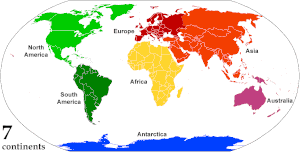
This is a list of Wikipedia science and technology articles by continent.

This is a list of Wikipedia science and technology articles by continent.
| | This section is empty. You can help by adding to it. (October 2016) |
| | This section is empty. You can help by adding to it. (December 2012) |
| Science and technology articles by decades |
| Decades |
| 1970s - 1980s - 1990s - 2000s - 2010s |

The 11th century is the period from 1001 through 1100 (MC) in accordance with the Julian calendar, and the 1st century of the 2nd millennium.

The second millennium of the Anno Domini or Common Era was a millennium spanning the years 1001 to 2000. It began on January 1, 1001 (MI) and ended on December 31, 2000 (MM),.
The timeline of historic inventions is a chronological list of particularly important or significant technological inventions and their inventors, where known.

Military technology is the application of technology for use in warfare. It comprises the kinds of technology that are distinctly military in nature and not civilian in application, usually because they lack useful or legal civilian applications, or are dangerous to use without appropriate military training.
A national academy is an organizational body, usually operating with state financial support and approval, that co-ordinates scholarly research activities and standards for academic disciplines, and serve as public policy advisors, research institutes, think tanks, and public administration consultants for governments or on issues of public importance, most frequently in the sciences but also in the humanities. Typically the country's learned societies in individual disciplines will liaise with or be coordinated by the national academy. National academies play an important organisational role in academic exchanges and collaborations between countries.
This is an index of articles related to the issue of feminism, women's liberation, the women's movement, and women's rights.

The history of technology is the history of the invention of tools and techniques by humans. Technology includes methods ranging from simple stone tools to the complex genetic engineering and information technology that has emerged since the 1980s. The term technology comes from the Greek word techne, meaning art and craft, and the word logos, meaning word and speech. It was first used to describe applied arts, but it is now used to describe advancements and changes that affect the environment around us.

An academy of sciences is a type of learned society or academy dedicated to sciences that may or may not be state funded. Some state funded academies are national, or royal as a form of honor.

The Four Great Inventions are inventions from ancient China that are celebrated in Chinese culture for their historical significance and as symbols of ancient China's advanced science and technology. They are the compass, gunpowder, papermaking and printing.
During the growth of the ancient civilizations, ancient technology was the result from advances in engineering in ancient times. These advances in the history of technology stimulated societies to adopt new ways of living and governance.
The following outline is provided as an overview of and topical guide to technology:

Ancient Chinese scientists and engineers made significant scientific innovations, findings and technological advances across various scientific disciplines including the natural sciences, engineering, medicine, military technology, mathematics, geology and astronomy.
Science and technology in Asia is varied depending on the country and time. In the past, among Asian civilizations considered particularly notable for their contributions to science and technology were India, China and the West Asian civilizations. Countries such as Japan, South Korea, and Taiwan are recently known for technology, while China and India are also major contributors to science and technology. Other countries are also notable in other scientific fields such as chemical and physical achievements. For the science and technology of various Asian countries and civilizations, see:

The following outline is provided as an overview of and topical guide to Iran:

The concept of engineering has existed since ancient times as humans devised fundamental inventions such as the pulley, lever, and wheel. Each of these inventions is consistent with the modern definition of engineering, exploiting basic mechanical principles to develop useful tools and objects.

Iran has made considerable advances in science and technology through education and training, despite international sanctions in almost all aspects of research during the past 30 years. Iran's university population swelled from 100,000 in 1979 to 4.7 million in 2016. In recent years, the growth in Iran's scientific output is reported to be the fastest in the world.

This is a timeline of the Five Dynasties and Ten Kingdoms (907–979), which followed the collapse of the Tang dynasty in 907 AD. The Five Dynasties refer to the succession of dynasties which ruled northern China following the Tang collapse while the Ten Kingdoms, with the exception of Northern Han, ruled in southern China. This era of division ended in 979 AD with the rise of the Song dynasty under Emperor Taizu of Song, although the Song would never reconquer the northern territory lost to the Khitans, collectively known as the Sixteen Prefectures.